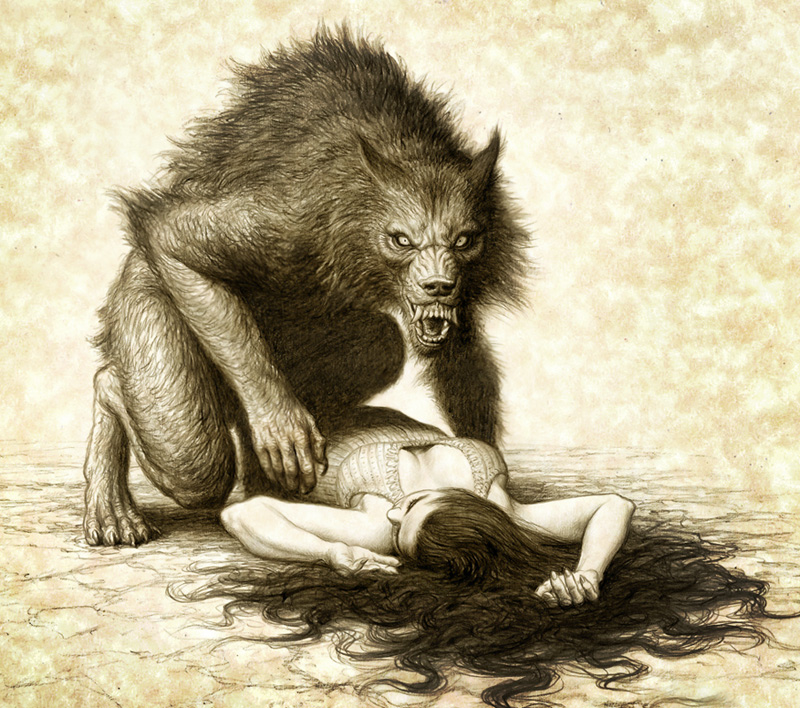Have you ever heard that at night the creatures come out, especially when there is a full moon. But whenever people think of a full moon, the thought of a werewolf might cross their mind. Because of the famous movie Twilight: New Moon, which was released in 2009, people might imagine a werewolf being Taylor Lautner turning into a huge wolf. However, before this movie was released to the big screen, werewolves were thought to be a thing of the night, actual monsters to fear.
In the past, werewolves are said to be the product of a human’s involuntary, typically only temporary, transformation into a wolf.1 They didn’t necessarily completely change into a full wolf, but had the appearance of being half-wolf and half-human. For quite some time during the medieval period, many couldn’t accept the fact that a man could transform into a wolf. They concluded that these werewolves were a product of magic, that witches used their magic to transform someone into a wolf, known as lycanthropy. With the use of magic, these werewolves were considered voluntary werewolves, as oppose to involuntary werewolves, who shifted into wolves because of their sins.2 After the transformation was made, people assumed a werewolf was a servant from the devil himself, and anyone accused of being one was put to death.3

The origins of these beliefs started in the Balkan area. In this region, the Dacians, who were an ancient people, had a wolf as their totem animal. With this being said, they believed that they were able to turn young men into wolves when performing a ritual.4 When this ritual was performed, they would imitate a wolf along with wearing wolf skins; this is because they believed the wolf should be highly respected for being a hunter. Even in Greek mythology, one can find stories about men transforming into a wolf. They told the story that the mighty Zeus became angry at a man named Lycaon, and for a punishment, he turned Lycaon into a wolf. With this story we get the term lycanthropy. However, some people believe that werewolves may be a relic of early cannibalism rather than just beings consulting with the devil. Communities of semicivilized people would begin to shun those who devoured human flesh, ostracizing them and classifying them as wild beasts.5 People who would willingly choose to eat a human being are not really human, but rather a beast, because they behave just as beastly as a wild animal.
The belief of werewolves may seem fictional to us today, but in the 1500’s, these beasts were thought to be completely real. In 1407, Basel Switzerland authorities claimed that they had the first official execution of werewolves, with several individuals being accused, then tortured and burned.6 Werewolf trials then took place in Poligny, France in 1521, when three men claimed they were consulting with demons in order to gain the power to transform into wolves. The men then confessed that they had killed and consumed several children for nineteen years. All three men were then burned at the stake.7

In the following years, many cases of people being werewolves were brought forward. One of the most famous cases was of Gilles Garnier in Dole, France 1573. No one understood why several young children disappeared in 1573, until Garnier and his wife were arrested and tried as werewolves. Garnier confessed that he had killed a twelve year old boy, and was going to consume his flesh, but was interrupted before doing so. Although he was in human form, some citizens claimed that he had appeared as a wolf. In his confession, he claimed to have killed a ten year old girl while being in the shape of a wolf, using his teeth and claws to devour her.8 He also claimed to have attacked a girl but was again interrupted; several days later he strangled a ten year old boy, ripping his leg off and eating his flesh. In both incidents he claimed that he was in wolf form. After all of his confessions, he was then burned alive on January 18, 1574.9

In another known case, a man named Peter Stubbe also claimed to be a werewolf. He possessed a magic belt that allowed him to transform from man to wolf. Although authorities never found his belt, he was beheaded for his crimes in 1589.10
Finding evidence of real werewolves was tricky, until 1598, with the case of Jacques Roulet. A group of hunters stumbled upon two wolves devouring a fifteen year old boy. Since they were armed, the hunters decided to follow the wolves. When following the tracks, the paws slowly started to become more human like. They finally reached the end of the tracks, finding a man with long hair and a long beard, wearing rags, his hands covered in blood, and his long nails contained bits of human flesh. Jacques claimed he had possessed a salve that would enable him to turn into a wolf.11 Although the cases of werewolfism died down, the idea of being a werewolf never disappeared.
Over time, the phenomenon of werewolves took a new shape. In 1935, the movie Werewolf of London opened, introducing a cinematic version of these supernatural beings. The plot of the movie was inspired by the true story of Francis Bertrand. Bertrand had been convicted in 1848 for breaking into several graveyards in Paris. He would dig up recently buried corpses and consume their flesh.12 The story was then transformed into a movie about Bertrand Caullet, a person who didn’t have the knowledge of being a werewolf until being shot with a silver bullet. The silver bullet was significant, as it became a reoccurring theme in later movies, including Frankenstein Meets the Werewolf in 1943, and later in An American Werewolf in Paris in 1997. With the use of the silver bullet, people stepped back from thinking of beheading or burning people at the stake as ways of killing these beasts. The concept of using a silver bullet emerged from the Scottish belief in the efficacy of using silver to kill witches.13 Another modern adaptation that emerged was in the ways one would become a werewolf. In the past, in order for you to transform you needed the help of a witch or magic, but that started to fade. Today popular culture has transformed the original belief into one that sees being bitten or scratched by a wolf or werewolf in order to become a werewolf. The reason for this change started with The Wolf Man film of 1941.
By the 1970’s, werewolves had become very popular in genres of horror: in movies, in books, and even in television shows. With the franchise of werewolves still growing, there are less cases of werewolfism today. Many doctors believe that what people witnessed wasn’t an actual werewolf, but rather a person suffering from a serious mental illness, along with a condition called porphyria. Porphyria causes people’s skin to turn brown and oddly textured. People who suffer from this disease also become sensitive to light, making them more comfortable with venturing out at night.[13. Encyclopedia of Occultism and Parapsychology, 5th ed., 2001, s.v. “Werewolf.”] However, even with the explanation of having porphyria, some still believe in the phenomenon of werewolfism. In one case, a forty-nine year old woman believed that she was a werewolf, even after receiving psychotherapy and antipsychotic drugs. She would be able to control herself until a full moon, but when the full moon arrived, she would behave like a wolf by snarling and howling.14
The perception of what a werewolf is has shifted over time, but judging by its origins, maybe it was for the best that we changed our thoughts of werewolves. Although we may never know if a man can truly turn into a wolf, we can’t stop people from believing in werewolves. The past has been proof that people believe in werewolves regardless whether it seems impossible. Just keep in mind the next time you decide to walk alone at night on a full moon, you never know what creature lurks in the dark of night.
- In Encyclopedia of Occultism and Parapsychology, 5th ed., 2001, s.v. “Werewolf.” ↵
- In The Greenhaven Encyclopedia of Paranormal Phenomena, 2006, s.v. “Werewolves.” ↵
- Encyclopedia of Occultism and Parapsychology, 5th ed., 2001, s.v. “Werewolf.” ↵
- In The Greenhaven Encyclopedia of Paranormal Phenomena, 2006, s.v. “Werewolves.” ↵
- Encyclopedia of Occultism and Parapsychology, 5th ed., 2001, s.v. “Werewolf.” ↵
- The Gale Encyclopedia of the Unusual and Unexplained, Vol. 3., 2003, s.v. “Creatures of the Night.” ↵
- The Gale Encyclopedia of the Unusual and Unexplained, Vol. 3., 2003, s.v. “Creatures of the Night.” ↵
- Encyclopedia of Occultism and Parapsychology, Vol. 1., 5th ed., 2001, s.v. “Garnier, Gilles (d. 1574).” ↵
- Encyclopedia of Occultism and Parapsychology, Vol. 1., 5th ed., 2001, s.v. “Garnier, Gilles (d. 1574).” ↵
- In the Gale Encyclopedia of the Unusual and Unexplained, Vol. 3., 2003, s.v. “Creatures of the Night.” ↵
- The Gale Encyclopedia of the Unusual and Unexplained, Vol. 3., 2003, s.v. “Creatures of the Night.” ↵
- Encyclopedia of Occultism and Parapsychology, 5th ed., 2001, s.v. “Werewolf.” ↵
- Encyclopedia of Occultism and Parapsychology, 5th ed., 2001, s.v. “Werewolf.” ↵
- In the Gale Encyclopedia of the Unusual and Unexplained, Vol. 3., 2003, s.v. “Creatures of the Night.” ↵



103 comments
Sofia Martinez
I really like this article because it depicts on the stereotype that movies like Twilight show a different mythology side of the misconception about werewolves and their origin. Learning that there was a whole community that admired and looked up and werewolves and were part of their rituals is very interesting because they are just animals and didn’t know that they seemed as important.
Julia Edwin- Jeyakumar
This article is very interesting because it challenges your thoughts on mythology! I didn’t think there would be any sightings but is it a recorded sighting? Like manuscripts and everything? I remember seeing this in vampire diaries cause my parents would let me watch twilight due to other suspicions. I wonder how it would work anyway, the word magic, the struck great fear in that time because it messed with the laws of physics and chemical physiology that we have today. Not only that, if it could alter the laws of physics, then it must have great power. I’m sure this was an interesting read for you too, to read all the interesting theories to explain lycanthropy.
Kasandra Ramirez Ferrer
I’ve always known or seen what werewolves are in movies or books, there are various versions of how werewolves look like and how they became one. However, I didn’t know there was a society that cherished this creature and even men would act like one and cover themselves with wolf skin to perform a ritual. I also find kind of funny how some societies would adore these creatures and some would fear them and kill anybody who was even suspect without hesitation.
Eliezer Leal
This was a great article, I love learning about old mythologies. I never knew that werewolves were so prominent in the past I always thought they just a scary story like Frankenstein but to hear there were actual executions of people for suspicion of being a werewolf is insane. This was an interesting article with a crazy mythological story.
John Estrada
Prior to this, I had no knowledge of the origin of Lycanthropy. Very informative an interesting to have derived from Greek mythology. Zeus turning a man named Lycan into a werewolf is interesting. It’s great to have information dating back to older times when people believed werewolves were real and the result of witchcraft. Kudos to the simple to follow timeline of the history of werewolves.
Roberto Rodriguez
It was very surprising to read about the acts of early cannibalism and how they were connected to werewolves. The case of Jacques Roulet and all other stories of werewolves are all very intriguing, it makes me wonder if there is a certain mental disease that would cause someone to be so cannibalistic to such an extreme degree. I had known of porphyria prior to reading this article and its possible linkage to the origins of werewolves. I always put the story of the origins of werewolves as some people that were just misunderstood with a rare disease and were labeled monsters. After reading about all the cannibalism… I am not sure about the origins to say the least.
Trinity Casillas
I never knew that there were two different types of werewolves at one time, involuntary and voluntary. The background story about the word lycanthropy and how it involved Zeus was very interesting to me because I would have never guessed that. It was interesting to see that werewolves were handled similarly to how witches were handled, like with trials, death by burning, and thoughts of being connected to the devil. Peter Stubbe’s story was interesting as his differed from others as he claimed a belt transformed him into a werewolf.
Todd Brauckmiller
After reading this article I definitely know more about werewolves then I did before. What caught my interest was how people claimed they’ve eaten other people as a werewolf and were executed for it. To be honest while thinking about that over and over in my head I found it quite scary and interesting at the same time. The big question is why confess like that when you know there gonna execute you after, I would at least say they did it to scare the folks into thinking that their some powerful deity. Other than that I found the rest of the article very smooth and transitioned well with the history and evolution of the werewolf.
Andrew Petri
This article is very interesting and does a great job at grabbing the attention of the reader with just the title. I have always been fascinated with mythology and werewolves, in particular, have always held a special place when it come to mythical creatures to me. After seeing many different movie adaptations and of shows about the creatures, it was very cool to read about the times when they were actually believed in and how people were actually convicted of being one.
Sharriah Martinez
This was a great article, I did not believe that people actually believed in werewolf’s i thought it was a folk tale, a story you say to scare children. I though they were made up for Halloween. It blows my mind that werewolfs were real to the people of the Renascence Era. I had no clue that there there were different types of wolfs. I had no idea about the different trials too.